'No Place to Hide' In Pakistan
Air Date: Week of June 7, 2024
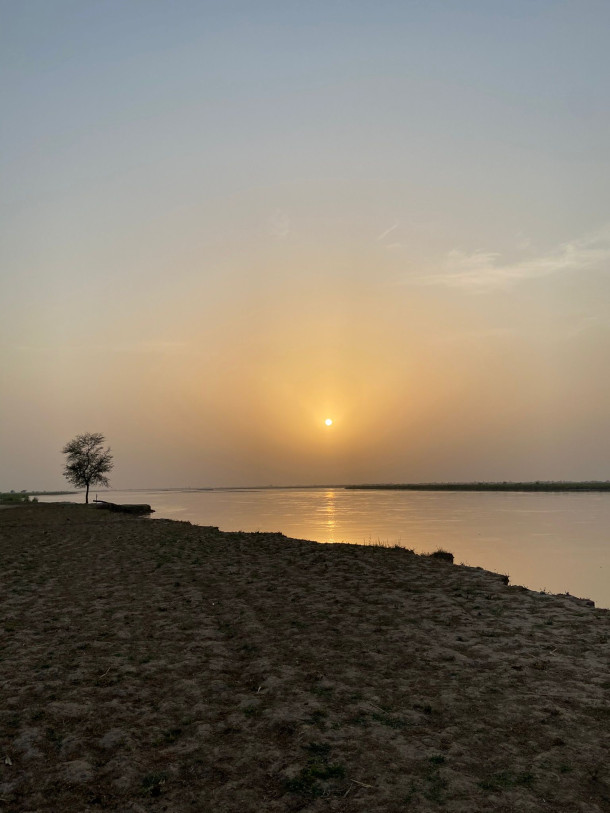
Jhelum River in the Pakistani province Punjab, on June 25, 2023. Summer heatwaves have recently hit temperatures of over 120 °F in the area. (Photo: Shanzay Asif)
Summer has barely begun in the Northern Hemisphere but extreme heat is already baking Pakistan, where climate disruption is also bringing frequent catastrophic floods. Rafay Alam, an environmental lawyer and member of Pakistan’s Climate Change Council, joins Host Steve Curwood to describe what it’s like to be in Lahore right now, how people are trying to cope and why these climate disasters are compounding Pakistan’s economic and security challenges.
Transcript
DOERING: It’s Living on Earth, I’m Jenni Doering.
CURWOOD: And I’m Steve Curwood. 2023 was the hottest summer on record in the Northern Hemisphere, and 2024 seems likely to top it, with torrid temperatures already sizzling the Southwest U.S., North Africa, South Asia and much of the Middle East. The climate emergency is not only battering whole regions with heat. Extreme storms and rain events are adding misery in places like Pakistan, which has yet to recover from catastrophic floods in 2022. And right now, Pakistan is in the grip of yet another extreme heat wave, with schools in the Punjab forced to close as some cities reached more than 120 degrees Fahrenheit. For a view from Lahore we are joined now by Rafay Alam, an environmental lawyer and member of Pakistan’s Climate Change Council. Welcome to Living on Earth!
ALAM: Thank you very much, Steve.
CURWOOD: With June just having arrived, summer has got a long way to go across Pakistan. How would you say summer has been different this year, compared to the last few years?
ALAM: Well, it is extremely hot in Pakistan. It's what's now called the Asian heat wave, or the South Asian heat wave of 2024. And we've seen temperatures since the middle of May through now, the first week of June, in excess of 50 degrees centigrade, which is, you know, it's well over 120 degrees. Lahore today, where I live, is 44 degrees centigrade, which is about 111 degrees Fahrenheit. The interesting thing is, while we are experiencing a heat wave right now, and I want to get into detail with that, April was the wettest April in all of Pakistan's recorded history. There were torrential rains in the northern and western parts of Pakistan that actually led to over 120 deaths. So what we are experiencing is not just a heat wave, but actively the climate crisis. And so, you know, I'm very clear that this is the coolest summer of the rest of our lives. It's only going to get hotter and hotter from here.
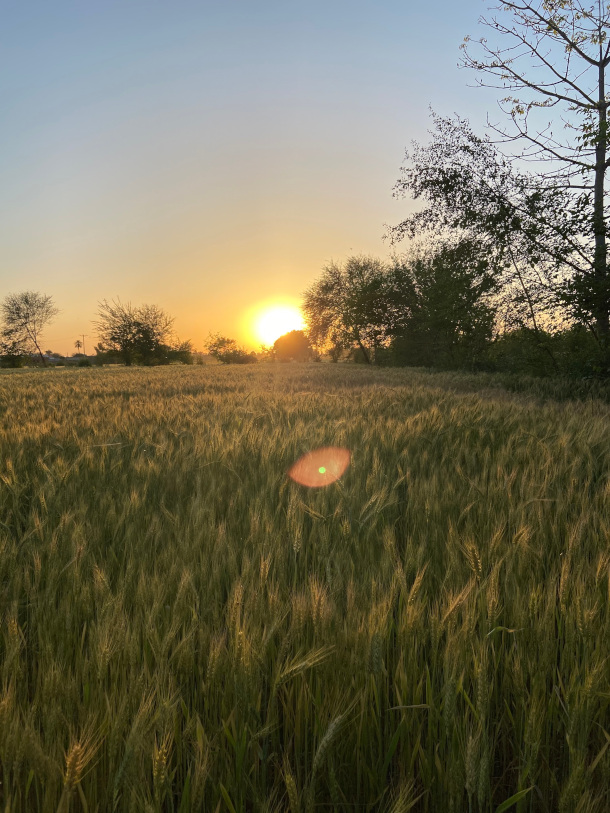
Wheat fields nearing harvest season. Due to the extremity of heat waves in recent years, Pakistan’s agriculture sector is being affected disproportionately. (Photo: Shanzay Asif)
CURWOOD: Yeah. Remind us of what happened with the torrential floods that you had in the recent past in Pakistan.
ALAM: Well, in 2022, we had historic floods, and we're talking 400 to 800% of monthly averages falling within a couple of weeks. And that, too, in areas outside the Indus Basin, which is Pakistan's major river network, so essentially, in places that couldn't drain the water away into the basin. And it was rainfall that saw not just flooding in our rivers, but also this 100-kilometer lake that was created by this rainfall, affecting over 30 million Pakistanis, displacing over 10 million Pakistanis, and causing in excess of $35 billion worth of infrastructure damage. That was just two years ago. And that was, again, in 2022 we had an early summer, summer started in March. We had a heat wave then. And then by July we had biblical floods, as it were. Last year, we had rains through April, which is unusual. And again, a warm summer. But this summer is breaking all records. We've had, incidentally, just a few days ago, a city in Pakistan, Mohenjo-daro, actually the home of an ancient civilization, that recorded 53 degrees centigrade, so in excess of 125 degrees Fahrenheit, and it was the hottest place on Earth last week.
CURWOOD: So, by the way, how has Pakistan recovered from those floods of 2022, never mind what's going on today?
ALAM: It's difficult to say, because a lot of the flooding took place, as I said, outside the Indus Basin, so outside where it could be drained, in really far-flung areas, not very heavily inhabited, but obviously very devastating for the people who live there. I mean, roads were swept away, schools were swept away, hospitals were swept away. And this sort of infrastructure takes years to rebuild. So we're facing a generation of Pakistanis who will grow up without access to hospitals, until the roads are built and until the hospitals are built, or even schools and the ability to get to work. So it is absolutely devastating. It crippled the Pakistani economy. I mean, $30, $35 billion of infrastructure loss is approximately 10% of our GDP, and we are in an IMF program at the same time. So our ability to economically stand on our feet has been made worse, much, much worse, especially by the fact that since the floods, a lot of the flood relief that we expected has come in the form of loans, and not things like grants and aid, which has doubled Pakistan's external debt in the last two years as well. So economically, very, very harsh. It's affected people, it's affected livelihoods, it's affected livestock. Truly devastating.
CURWOOD: It sounds just horrible. So let's talk about today, now. You're in Lahore, Pakistan. What are people doing there where you are to cope with this insane heat wave?
ALAM: Well, we have advisories. We have something called the National Disaster Management Authority, which has a heat wave plan for all of Pakistan, which generally involves letting people know that it's dangerous to go out, to consume lots of water. Also in Punjab, which is the province that I live in, first of all, school timings were changed so that schools wouldn't be let off in the mid afternoon. They were being let off by 12, one o'clock. And then as temperatures rose, schools were shut down throughout Punjab. We've had hundreds of people affected with heat waves. And I should also point out, in 2014, the Pakistan's largest city, Karachi, faced a week-long heat wave where over 1,000 people died. And we're reaching those sorts of temperatures right now, which puts human lives at serious risk. So we're seeing all of these things play out, and I might also—I mean, I go for a walk in the evenings when the sun sets. It's not unpleasant, but I noticed driving around and walking, animals, birds, collapsed to the ground looking for water. Dogs on the side of the road unable to get up. And I recall that this heat wave affects the wildlife in Lahore as well, the birds, the cats, the dogs, the other animals as well, who are hugely put out by just the amount of cement we have in our cities. As you know, cities are usually warmer than other parts, you know, where there's natural vegetation, something called the urban heat island effect. So while it might be 50 degrees centigrade outside, it might feel several centigrades higher than that. And it's impacting everyone.
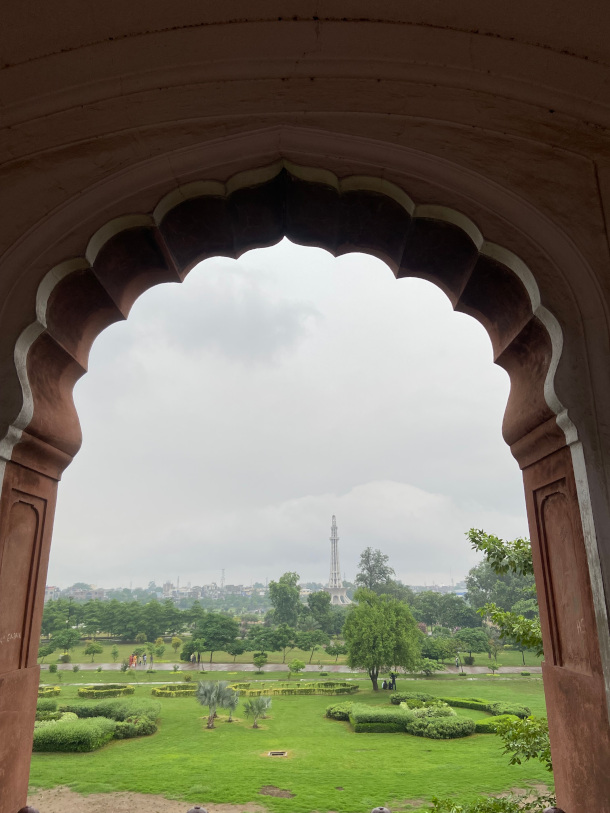
Amid scorching heat waves, the city of Lahore awaits the respite offered by the monsoon season. Pictured above, a view of the Minar-e-Pakistan after a monsoon cleanse in late July. (Photo: Shanzay Asif)
CURWOOD: So as a member of Pakistan's Climate Change Council, what's to be done? What you folks in government doing to help people cope with this situation?
ALAM: Well, I mean, I'm a member of the Council, but the less said about it, the better. It's only met four times in its last seven years. And mostly to agree on what Pakistan's position at the Conference of Parties is going to be at. We're a country of over 200 million people, a vast majority of whom are now exposed to dangerous amounts of right now dry heat, which is also dangerous. But as the monsoons, the rain precipitation comes in towards the end of June and July, we're going to see rising humidity levels and something called wet bulb temperatures, where even at lower temperatures, if the humidity is higher, so for instance, if you're at 95 Fahrenheit and 70% humidity, it will feel like it's over 120 degrees Fahrenheit. And especially with the higher humidity, it becomes very, very difficult for the human body to release heat on its own through sweating. So people essentially will bake in these sorts of temperatures. So we are extremely at risk of high temperatures, not just human beings. But then Pakistan's economy, we have about 20% of our GDP is from agriculture. And just a few days ago, one of the leading English newspapers had a headline about how crops were being decimated in Pakistan. Cotton crops basically sizzling. Maize crops, mango crops, other vegetables and fodder for animals as well. So there is going to be a decline in crop productivity, which of course equates to a decline in farmer livelihood. And although farming contributes about 20% to the GDP, nearly half the Pakistani workforce is associated with agriculture. So we're talking about these temperatures and the loss they're causing to crops really pushing Pakistan's workforce towards or under the poverty line as well. Now, not just human beings, not just crops, but crops being decimated by heat. But as a result of the heat, there is an increased demand for water and for energy, water for crops to prevent them from burning, and then energy as people turn fans and air conditioners on. And we've seen in the last couple of weeks, our old grid system collapse under the sort of accumulated weight of this spiking demand. So and that's its own problem, because with these sorts of temperatures, people actually need shelters, we need to have places where people can go and have access to electricity, to things like air conditioners, because, you know, wet bulb temperatures, it doesn't matter if you have a fan, the humidity won't allow you to, to sweat, you need to have access to air conditioners and electricity. So we're also suffering an energy loss or a loss in energy because surging demands. So all of these things have to be looked at.
CURWOOD: What are the risks here? How important are those risks?
ALAM: You know, central to my argument here is that the World [Weather] Attribution group, which looks at climate events throughout the world to see whether or not they can be attributed to global climate change and global warming, has already stated that the heat waves last year and this year are on account of the 1.2, 1.4 degrees centigrade global warming we've experienced. So these heat waves are not a natural occurrence. This is very much a manmade occurrence. People like myself, people in Pakistan, people in India—by the way, over 55 people have died in India because of heat waves. So this heat wave is a manmade event due to the greenhouse gases consumed and thrown into the atmosphere by the Global North since the industrial revolution. So at some level, these greenhouse gases have to stop. Otherwise places like Pakistan, which contributes less than 1% to global greenhouse gas emissions on a year-to-year basis, is paying the bill for other countries' industrial and economic expansion. You have to stop those greenhouse gases. Otherwise people throughout South Asia are going to be exposed to high and very dangerous levels of temperature, which is also going to produce these dustbowl conditions in our agriculture belts. We have to change the way we do agriculture; we'd have to have heat-resistant crops. We grow our own food right now, but there's no crop in existence that can withstand 50-plus-centigrade temperatures. We have to come up with better varieties of seeds that are more heat resistance. We have to come up with other forms of agriculture, large-scale agriculture that can take this rapid increase in temperature. We have to change our water economy. I've already mentioned that agriculture contributes about 20% to GDP, but over 90% of Pakistan's water goes to agriculture. We have to find a better ratio where this water can be used to provide resilience and sustainability to Pakistanis going forward. I mean, it's confounds me to think that 90% of Pakistan's water is used to produce 20% of its GDP, and employs 40% of its workforce close to or at the poverty line. And we need to change the way our cities are designed. The cities are designed for cars. They're not designed for human beings to withstand these temperatures. I'm not sure how to go about this redesign. But these are the big, bold things we need to do in the face of dramatic climate change.
CURWOOD: Let's talk about today. You say 40%, half to 40% of the workforce in Pakistan is in agriculture. And yet, you can't stay inside, you can't be by a fan or an air conditioner if you're working in agriculture. What's happening to the people who are working outside?
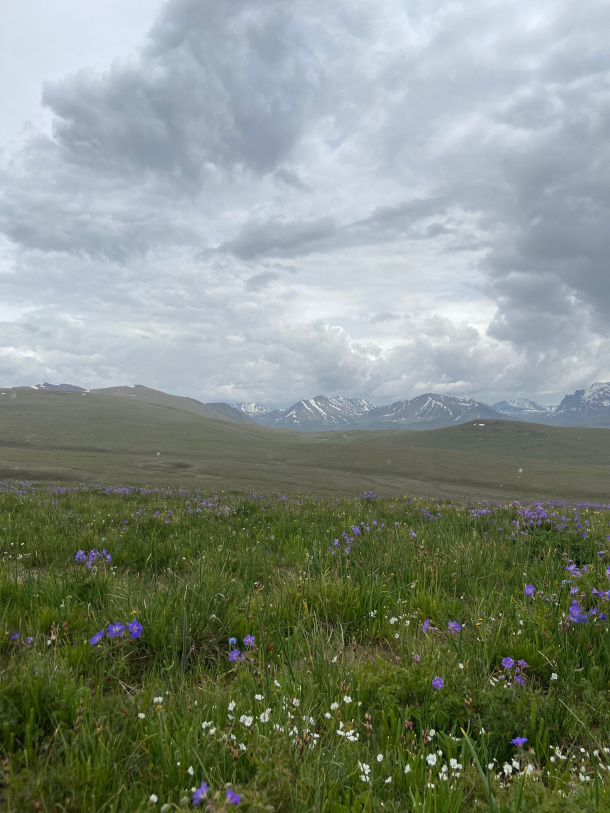
Deosai Plains, Skardu are at an average elevation of 4,114 meters (13,497 ft) above sea level and considered the second highest plateaus in the world. Pakistan’s natural wonders are widely under threat from climate change. (Photo: Shanzay Asif)
ALAM: Millions of people at risk of exposing themselves to dangerous levels of heat. But at the same time, this is harvest season. So they are people who are working. But luckily they wake up when the sun rises, they do a couple of hours work before it gets really, really hot, they’ll go back inside and they'll do a couple of hours work when it gets a little bit cooler in the evenings. But it is incredibly disruptive and dangerous at the same time.
CURWOOD: What you're describing, how's that different from an apocalypse?
ALAM: Oh, Steve, climate change is everything change. This is it. This is the coolest summer of the rest of our lives. We have put so many greenhouse gases into the atmosphere as a society that's chosen these decisions to block in a 1.5-, 2-degree global warming by the middle of this century, if not quicker. You see, Earth's ecosystem's been in balance since the last ice age, a balance that's allowed us to do enough agriculture to have human civilization, so that you and I can speak like this. That civilization is over. I mean, it's not like human beings are gonna become extinct. But this way that we interact with each other, extremely heavy energy use, extremely heavy water use, incredibly consumptive of natural resources, producing greenhouse gases for just about anything. I was reading something recently that the, the YouTube viral hit Despacito that reached 5 billion views on YouTube just a few years ago, expended enough energy on YouTube to power 40,000 U.S. homes for a single year. It's this behavior, this civilization, which is at risk. And yes, it is very much an apocalypse.
CURWOOD: There's a civil defense official who's asked people not to put cooking gas cylinders in open areas as a safety measure. And he's also warned the people living near fields that snakes and scorpions could enter homes and, and storage places in search of cooler spaces. What is he talking about?
ALAM: I think this is something that's heavily localized. A lot of domestic energy use in Pakistan is off of gas, and it's stuff that we use our ovens and our stovetops for. And with the weaker distribution system, a lot of rural areas rely on cylinder-based gas for their domestic purposes. And again, high temperatures, we're talking people in villages. So this is civil defense as part of the National Disaster Management Authority. And I'm glad to hear that some of their recommendations involve putting those canisters into cooler places and in shade. And then scorpions and snakes. Rural Punjab, rural Sindh, where there are scorpions, snakes, there are other animals as well. And like I said, they are being heavily impacted by this heat wave as well, and they're gonna look for shade. So be careful, especially if in the rural areas in Pakistan. You might meet some nasty creepy crawlies when you go into your hut.
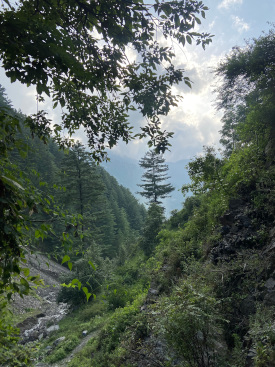
A view of the serene mountains of Nathiagali, a popular summer destination for Pakistanis trying to escape the heat in their hometowns. (Photo: Shanzay Asif)
CURWOOD: Now, I imagine you've lived in Pakistan for much of your life. When did you wake up and say, Whoa, what's going on here?
ALAM: I was made aware of climate change 2008, 2009. That was also around about the time Al Gore's video An Inconvenient Truth came out. And every year, we see changes in precipitation. We see rainfalls when it shouldn't be raining. We—the wettest April that I was talking about just two months ago, it was again devastating for crops, because these were crops approaching harvest time, and if you're met with a heavy rain, a lot of the crops just fall down and rot. So there was already devastation because of that. We've seen these sorts of things. And people don't in Pakistan tend to think it's climate change but unlivable amounts of air pollution. And this is very much our own doing. This isn't greenhouse gases coming out of the Global North. This is some of the worst-quality fuels that we have. And as a result of which, fuels that we use in our energy sector and in automobiles, that on average, in Pakistani cities, you're losing two to three years of life expectancy. And in my city of Lahore, it's seven to eight years. So we've been seeing these chronic air pollution episodes since at least 2016. So this is happening all the time. We're seeing it every single day. There is a significant denialism on climate change in places like the United States. And it, it angers me, because I see people affected. I see animals affected. And this is a lived experience for the global majority, the Global South. And it's extremely infuriating to see people who've participated in this global warming deny it, deny any accountability, and try and move on as if nothing's happened, and try and continue to make money and drive that bottom line.
CURWOOD: You're an attorney, you're a lawyer, and perhaps not a political scientist. But what do you see are the political implications of this in terms of regional stability and worldwide stability?
ALAM: I am not a political economist or a political theoretician, but there's this fellow called [Anatol] Lieven in the United Kingdom who wrote a book on climate change and the nation state, and his thesis is that the nation state emerged in the 18th and 19th century from the kingdoms that ruled Europe. And it's predominantly a security state, you're involved in securing yourself against aggression from other states, but not from an existential threat like climate change. And so the very basis of the legal systems and the international system that we have, he argues, and I tend to agree with him, can't cope with an existential crisis like this. I mean, one of the worst ways to deal with something like climate change is to divide the world into 200 different countries and have them argue with each other. So this does not augur well for regional stability, not that there's a considerable amount of regional stability in Pakistan right now, or in and around Pakistan, because on one side, we've got Afghanistan. On the other side, we've got India, with which we've had an acrimonious relationship for most of our life. So we're not talking to either neighbor, which can't be good at the end of the day, because people are important. And there are also climate-induced migrations, a lot of them, of course, political as well, when it comes to Afghanistan, but climate-induced migrations that we have no consideration for, because there is still no legal definition of a climate migrant internationally. So there's that we don't have our eyes open for that. So it doesn't augur well for regional stability going forward, or even the international order.
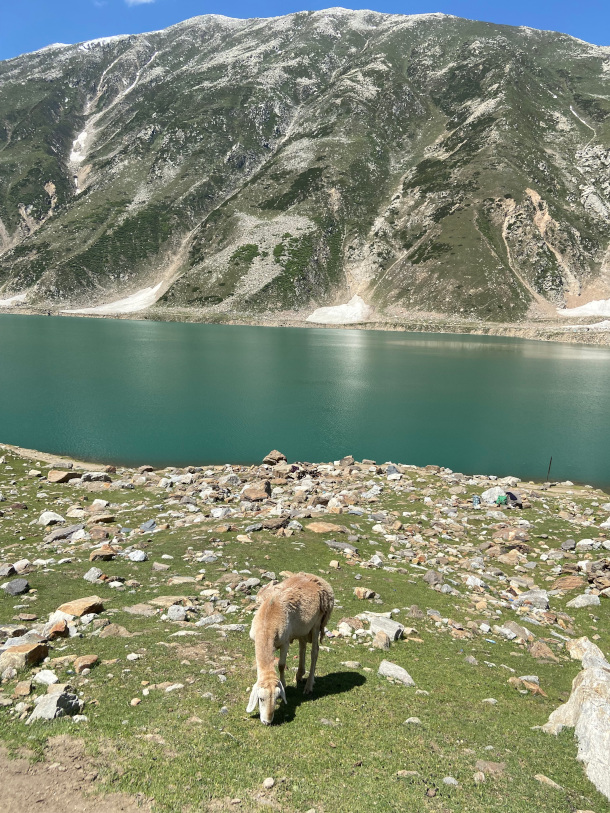
Melting snow on the typically-snow-capped peaks of Naran Valley, draining into Saif-ul-Malook Lake. Excessive melting in 2022 led to intense flooding. (Photo: Shanzay Asif)
CURWOOD: What portions of Pakistan are less vulnerable to climate disruption, and where people might be migrating to?
ALAM: Well, vulnerability is interesting. I mean, of course, vulnerability is the strength of your infrastructure to withstand climate events, but also vulnerability at a higher level, your ability to get on your feet if you've been pushed to the ground. And this is dramatically different, not just on an infrastructure scale, but a scale of affluence, right? The richer you are, the more likely you are to be resilient to climate impact. And the less affluent you are, the more likely your home's going to get swept away. But my concern really comes to the majority of the Pakistani people, you know, who are middle class, working class, and at or close to the poverty line, that their ability to withstand climate shocks is much weaker than my own. So we have to understand vulnerability in that way. So where in Pakistan is vulnerable? Most of it, because most of it is poor, and you'll have some pockets of rich Pakistan that will be less vulnerable. If you think you can head to the mountains and enjoy some cool weather over there, well, we have over 3,000 glaciers in Pakistan which are at risk of something called glacial lake outburst floods, which are when the water of the glacier unexpectedly and unannounced makes its arrival and can be quite devastating. So 3,000 of those glaciers, some of which have split and burst and caused knocked-out roads, and especially up in the northern areas when we're talking roads and bridges that connect valleys and mountain ranges, if you knock out one of those you more or less knock out an entire region from other transport logistics, so you're not safe there very much either. Then if there's an excessive rainfall, the, the rivers that pass through the mountains can also disgorge themselves with flood. I'm sorry, Steve, there's really not many safe places unless you find a rich friend and stay in their house.
CURWOOD: No place to hide.
ALAM: No place to hide.
CURWOOD: Rafay Alam is a Pakistani environmental lawyer and member of Pakistan's Climate Change Council. Thank you so much for taking the time with us today.
ALAM: Thank you very much, Steve, for having me.
Links
AP News | “Weather Forecasters Warn Pakistanis to Stay Indoors Ahead of New Heat Wave”
Euro News | “Pakistan Heatwave: Hundreds Treated for Heatstroke as Temperatures Soar to Over 50C”
Living on Earth wants to hear from you!
Living on Earth
62 Calef Highway, Suite 212
Lee, NH 03861
Telephone: 617-287-4121
E-mail: comments@loe.org
Newsletter [Click here]
Donate to Living on Earth!
Living on Earth is an independent media program and relies entirely on contributions from listeners and institutions supporting public service. Please donate now to preserve an independent environmental voice.
NewsletterLiving on Earth offers a weekly delivery of the show's rundown to your mailbox. Sign up for our newsletter today!
 Sailors For The Sea: Be the change you want to sea.
Sailors For The Sea: Be the change you want to sea.
 The Grantham Foundation for the Protection of the Environment: Committed to protecting and improving the health of the global environment.
The Grantham Foundation for the Protection of the Environment: Committed to protecting and improving the health of the global environment.
 Contribute to Living on Earth and receive, as our gift to you, an archival print of one of Mark Seth Lender's extraordinary wildlife photographs. Follow the link to see Mark's current collection of photographs.
Contribute to Living on Earth and receive, as our gift to you, an archival print of one of Mark Seth Lender's extraordinary wildlife photographs. Follow the link to see Mark's current collection of photographs.
 Buy a signed copy of Mark Seth Lender's book Smeagull the Seagull & support Living on Earth
Buy a signed copy of Mark Seth Lender's book Smeagull the Seagull & support Living on Earth

